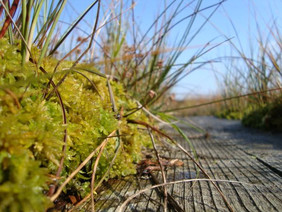Within the PEATWISE project, researchers from six European countries and New Zealand developed action and policy recommendations for peatland management that focus on greenhouse gas mitigation. The options studied included paludiculture with peat mosses, reeds, bulrushes and reed canary grass.
From Germany, the Leibniz Centre for Agricultural Landscape Research (ZALF) participated.
Researchers from Denmark, Finland, Germany, New Zealand, the Netherlands, Norway and Sweden tested established and new methods for greenhouse gas (GHG) reduction on peatland soils in country case studies by carrying out GHG measurements. They also interviewed experts on the prospects for peatland management until 2050.
It was shown that the correct water level in combination with the appropriate plant species is crucial to achieve very large GHG reductions in paludicultures. The cultivation of peat mosses and reeds led to substantial GHG reductions. Peat moss crops in particular achieved positive GHG reduction effects already in the first years after rewetting. For other paludicultures, the point at which saving effects are reached has not yet been found.
Ideally, the water level should be 10 cm below the ground surface in the summer months, but in practice this usually cannot be maintained. Permanent overwatering in summer leads to a significant increase in methane emissions in the early years, which can overcompensate the CO2 savings in exceptional cases due to their strong climate impact. This is especially true if the water is rich in carbon or nutrients and extensive grassland is rewetted, which itself already had a relatively high water level and corresponding low GHG emissions. The methane emissions are caused by existing biomass from the previous land use. In the long term, GHG emissions in natural cattail (Typha) stocks are usually lower than in drained peatlands, even with overbanking, and never higher. For cattails in paludiculture, there remains a need for further emission measurements. However, experiments in PEATWISE already showed that potential methane emissions also significantly decreased after two years in nutrient-rich paludiculture with high water levels.
Peat mosses (Sphagnum) and reeds (Phragmites) are well suited for cultivation at a water level around -10 cm. Cattails (Typha), on the other hand require flooding.
In order to avoid nitrous oxide emissions, which also have a strong impact on the climate, paludiculture areas should not be fertilised. Here, the nutrient and carbon inputs are sufficient, e.g. via irrigation from receiving waters.
Policy recommendations
Researchers from the PEATWISE project also developed policy recommendations to enable climate-smart management of peatlands. These include the following points:
- Coordinating institutions are needed to mediate between the stakeholders involved. The Dutch "cooperatives" in which farmers join forces to achieve environmental goals together and in close coordination with nature conservation and administration can serve as a model. In Germany for example, landscape management associations in cooperation with water associations could play this role. The background to this is that efficient and effective peatland protection should generally not take place on individual plains but in larger patches of land.
- Paludiculture should be eligible for support under the future Common Agricultural Policy (CAP) - Germany has implemented this demand in its CAP strategic plan. The intention is that paludiculture will be eligible for support in the funding period 2023 to 2027 if it contributes to one or more of the objectives of GHG reduction, promotion of biodiversity and protection of natural resources such as water, soil and air. The EU has yet to approve the strategic plan. How complex the proof of the contribution of paludiculture to the above-mentioned goals will actually be in practice remains uncertain.
- Member states should set up national programmes for peatland-friendly management using EU funds, e.g. from the Agricultural Fund for Rural Development (EAFRD) or the European Regional Development Fund (ERDF).
- Many established measures, such as meadow bird programmes in the Netherlands, grassland extensification in Germany or perennial grasses in Finland, which currently do not directly target the ground water, could be extended for a transitional period.
- Programmes and compensation for rewetting of agricultural land must be cost effective and long-term (at least 10 to 15 years). This would significantly increase the motivation of farmers and other landowners to enter into wetland management.
- Targeted subsidies aimed at expanding or renewing drainage in peatlands should be scrutinised very closely in terms of their climate impact.
- Political targets for peatland soil protection should be legally binding to send a strong signal.
- Economic incentives alone are not sufficient for ambitious climate targets on peatlands. Complementary regulatory measures are needed such as an end to the payment of EU funds for drainage-based agriculture on peatlands.
PEATWISE was funded in the frame of the ERA-NET FACCE ERA-GAS. The German project partner ZALF received funding from the German Federal Ministry of Food and Agriculture (BMEL) via the Agency for Renewable Resources (FNR).
The final report of the project "Sustainable use of drained peatlands in the bioeconomy: development of optimised assessment approaches and sustainable techniques for the avoidance of greenhouse gases (PEATWISE)" from ZALF is available at fnr.de (in German) under the funding code 22408917.
More information: https://www.eragas.eu/en/eragas/Research-projects/PEATWISE.htm
FNR contact person:
Fachagentur Nachwachsende Rohstoffe e.V.
Birthe Dehmel
Tel.: +49 3843 6930-207
E-Mail: b.dehmel(at)fnr.de
Press contact:
Fachagentur Nachwachsende Rohstoffe e.V.
Nicole Paul
Tel.: +49 3843 6930-142
Mail: n.paul(at)fnr.de
PM 2022-37

